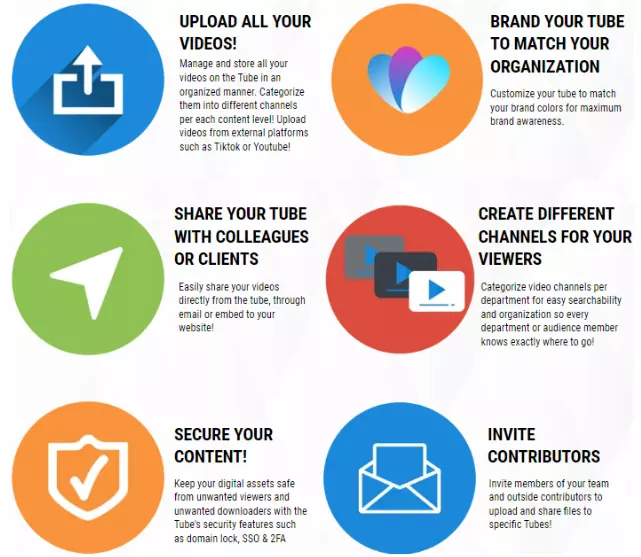The CincoPanelists event was held to find out from various content publishers how to get more out of their video assets. Experts from the digital publishing industry were invited to share their tips, tricks and best practices.
The CincoPanelists Event
At the CincoPanelists event held on August 24, 2022, experts in the content publishing industry spoke about how they have evolved through the centralization of their digital assets. Kiefer Hazaz, Chief Revenue Officer of Cincopa Media, was the host of the event. Emma Caputo, Marketing Channels Manager at Cincopa Media, was the moderator.
The CincoPanelists
Billy Harper, Director of IT and web services at Community Oncology Alliance
COA Cancer is a non-profit organization that advocates for the patients it serves and community oncology practices. It does many informative and educational videos for practices, doctors and nurses.
Andres Galofre, Co-founder and CEO of DocRed
DocRed is a digital medical platform that allows a community of physicians in Latin America to interact and communicate. It uses video and multimedia content to keep them informed.
Dave Dennis, CMO of Unified Mindfulness
Unified Mindfulness has an engaged community of qualified, skilled leaders and a goal to train and certify mindfulness teachers. It creates both live and video on-demand content.
Inge Dziembowski, MD of Eclipse Streaming
Eclipse Streaming is involved in the development of streaming services in the online radio industry and corporate healthcare education in South Africa. It delivers streaming events all over South Africa and in neighboring countries.
Topics of Discussion
How to Centralize Your Digital Assets
Billy Harper: He talked about how his company started with a small amount of video and tried to create a custom solution but soon found that the throughput and user experience was less than acceptable. The answer for them was a centralized platform.
Andres Golofre: He talked about the importance of having good content in one place so it could provide a useful user experience for physicians. By centralizing its digital assets in one place, the company could provide a more engaging experience for physicians all over Latin America. A consistent format was important to offer a good user experience.
Inge Dziembowski: She stressed the importance of quality content and said that buying into a higher-end platform helped the team to manage all its content and keep it secure for contributors and viewers. She believes the centralization of assets is a no-brainer.
Dave Dennis: He believes in a central hub you can rely on so that everybody can connect in one spot. If your content is all over the place, you can lose tons of valuable content.
Manage Your content like a Pro to GAIN MORE
Develop a roadmap for users
Inge talked about not only producing great content but producing highly targeted segmented content. Developing a roadmap for users helps them to navigate through content so that they can ultimately find what they’re looking for, learn from it and integrate it into their lives.
Andres confirmed that his company delivers content for all physicians, but there are different specialties and the challenge relating to a Mexican, Colombian or Argentinean physician. He said it is a challenge to identify individual needs, manage many types of content and choose the best content. He emphasized the importance of using a schedule with different key topics and who might be able to produce good content.
Managing metrics
Kiefer asked Dave about doing a big event every few months and then providing video on demand in between. How easy was it to manage metrics? Dave said the company has established some really good feedback loops with its audiences. It has a main audience that is becoming aware of the company and an internal community and team. The company has different messaging for each and different ways to measure both.
For a big live event, the company may have 10,000 people streaming simultaneously during a five or seven-day period. It tries to get their feedback ahead of the event to tailor content specific to what they want. He says that the team looks out for viewers who watch videos in niches or segments and finish content completely as they are likely to become clients.
Measuring results to improve conversion
According to Dave, measuring results ultimately comes down to conversion and improving revenue. It’s really important to be able to measure from the first click into the funnel to measure the lifetime value of that customer.
Dave’s company tries to have the audience shape the content that it produces for live events, and then all the live events convert to video on demand. For live events, the main focus is engagement and reaching as wide an audience as possible. Messaging might resonate with 1% or half a percent of the people. Offering video on demand reaches the 98% that don’t attend live. Once people join an email list or the community in some way, it’s possible to shape their user experience specific to their goals and interests.
Benefiting from a hybrid environment
Kiefer then asked Billy about how a non-profit organization measures live events and VOD. He said that ultimately it wants people to become members of COA. The more people they have connected to them, the more it helps when they have to rally the troops for a lobbying effort. When they pivoted to a virtual event environment during Covid, they found that three times the amount of people attended the virtual event than on-site conferences. They’re seeing that a hybrid environment has great potential.
Managing contributors and security
Kiefer asked Inge how the company manages processes with contributors and keeps it professional and secure. She believes the content creation process should be as standardized as possible. Even though there’s a wide variety of content the team creates, they stick to standardized and modular workflows.
The company is also almost over-sensitive to security and recognizes it happens on two levels. There’s infrastructure security and user security. It’s important to get the balance right between security and ease of access. Security has to be almost uncompromising, but it’s different when dealing with public content. You need to train your internal team and get them into the flow of standardization and security and balancing the two.
Dave again emphasized the importance of having a centralized platform with consistent analytics you can dig into. This offers insight into what is resonating with people. When you can see some consistent pattern in the data, it really helps to shape your organization.
Broadcasting Simultaneously
Broadcasting is no longer just for the big broadcaster.
Adaptive rendering: Inge brought up the issue of consuming content on different devices and adaptive rendering of content. Her team has had a byline for many years, which is “any device, anytime, anywhere.” She also spoke about the use of engagement tools such as live polling, which can really draw in audience members.
Broadcasting OTT: Kiefer wanted to know whether the market is ready to consume this type of content or if it is too early in the game.
Billy said that when broadcasting technical kinds of content, watching that on the big screen is ideal. He said that the market might not be quite ready, but companies need to prepare for it. The key is to put all content on the same hosting environment, so it’s ready to go out to all the different devices at any time. In the medical community, TVs in waiting rooms are commonly used to broadcast content. Ease of use is a big thing, and OTT definitely provides for that.
Dave believes you can’t even think about streaming to different devices and all the technical aspects unless you invest in a platform that helps you to reach across devices and stream effectively. You need a partner that can help you syndicate and broadcast content so that you can focus on producing it.
A multi-channel approach: The broader the target audience, the more multi-channel strategy needs to be in terms of content distribution. Some solutions are very expensive, and an OTT can come across that way but taking the opportunity to explore and look at pricing is important because it can be very effective down the road.
Question and answer session
Securing content: Inge answered a question about how to secure content between departments and multiple locations to make sure it doesn’t end up in the wrong hands. She said that encryption has to be a standard content protection measure.
Content publishers and distributors need to do an audit on their security and ensure that the right eyes are going to be on the right content.
Creating different visual formats: Billy answered a question about streaming on several platforms and devices at the same time and the importance of creating different visual formats according to the device. He said that most devices will handle a 16.9 ratio.
Is 720px still good enough? Billy’s answer was that if you are going to put effort into production, you need to render it at a higher resolution, especially if you intend to go into TVs. You need to go for 1080 if you can.
How much content is too much? According to Dave, there is never too much content. From his experience, what drives engagement more than anything is live content.
Why use CincoTube?
CincoTube is a corporate video tube that provides a solution for those who want to centralize their digital assets on one platform.
With centralization, you can organize and manage your digital assets so all those who need to access them can easily find them. You can create public or private video channels to which users can subscribe. By having access to public or private channels, different levels of user access are made possible.
You have access to advanced analytics and heat maps to get in-depth insights that help you to improve your content.
Adaptive rendering enables you to serve videos to the right person at the right time on the right device at the right bandwidth and on any platform.
Companies can offer live streaming and video on demand when using CincoTube as video tube.
To sum it up
There are many reasons why the centralization of your digital assets is important. It gives you more ability to protect, organize, manage and distribute them, so you get the most ROI. Using a centralized platform is the best way to deliver high-quality video content at all times, whether you’re streaming live or offering video on demand.













